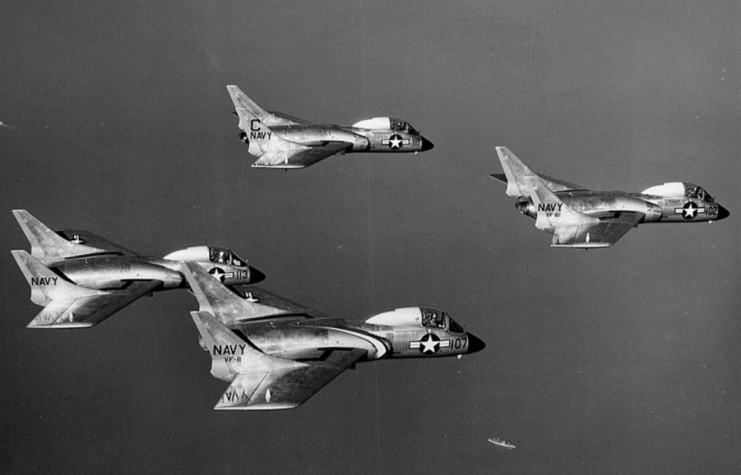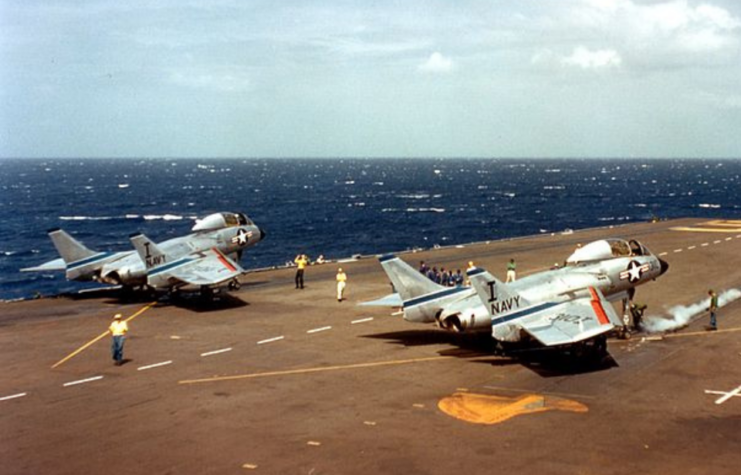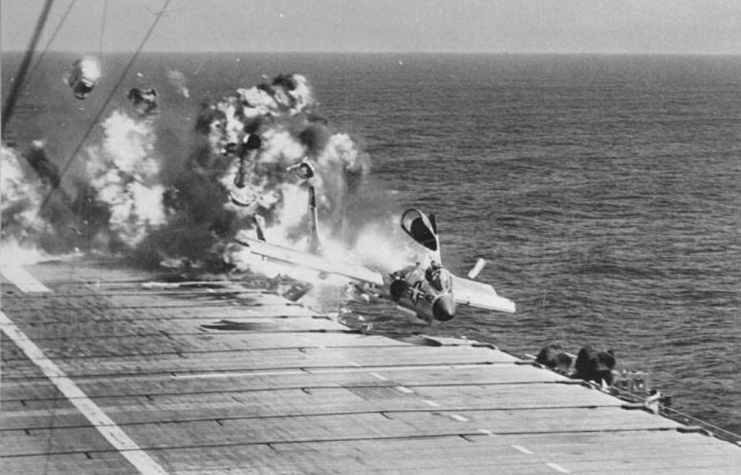The Vought F7U Cutlass was a carrier-based aircraft that served with the US Navy between 1951-59. Developed with the use of German research taken by the Americans at the end of the Second World War, it featured a non-traditional design. That being said, the jet suffered a number of issues during its tenure, which saw the loss of a quarter of those developed and the deaths of four test and 21 naval pilots.
Development of the Vought F7U Cutlass

Vought F7U-3 Cutlasses with Fighter Squadron 81 (VF-81), 1954. (Photo Credit: US Navy / US Navy National Museum of Naval Aviation / Wikimedia Commons / Public Domain)
Following the end of the war in Europe, the US Navy opened a competition for a new carrier-based fighter that could reach up to 600 MPH at 40,000 feet. The F7U Cutlass was Vought’s entry. It was the final aircraft designed by Rex Beisel, who’d worked on various others, including the F4U Corsair.
Contributions by Woldemar Voigt also impacted the design. Voigt had worked for the German company Messerschmitt AG and was part of such aircraft designs as the P.1110 and P.1112. While neither went beyond the drawing board, they showed significant evolutions in aircraft design.
The F7U presented a radical evolution. This, however, didn’t guarantee it was good. Naval aviators were quick to come up with several telling nicknames, including the “Praying Mantis,” the “Gutless Cutlass” and the “Ensign Eliminator.”
The F7U first took to the air in September 1948, and problems were soon discovered. All three prototypes crashed, and of the first 14 production aircraft, two wound up in the ground. The early F7U-1s were ultimately not approved for service with the Navy, nor was the F7U-2, which was never built.
With the necessary improvements made, the Navy accepted the F7U-3. It was more stable and maneuverable than the others, although Wally Schirra, a test pilot and astronaut, described the aircraft as “an accident looking for a place to happen, a widow maker.”
The F7U-3 was the final and operational variant, with 288 operating with 13 squadrons. Further development was ultimately abandoned after Vought developed the F-8 Crusader.
Vought F7U Cutlass specs

Vought F7U-3M Cutlasses with Attack Squadron 86 (VA-86) aboard the USS Forrestal (CVA-59), 1956. (Photo Credit: Capt. I.F. Brown / US Navy / US Navy National Museum of Naval Aviation / Wikimedia Commons / Public Domain)
The F7U Cutlass was a single-seat fighter that had a striking design. The cockpit was located in the nose, which was situated far ahead of its large, almost rectangular, swept wings. At the wing root were the intakes for the two jet engines, and, at the rear, the main fuselage had no vertical stabilizer. Instead, two were located a third of the way out from the fuselage, on the wings.
Two Westinghouse after-burning turbojet engines powered the Cutlass. At first, it was powered by the J34 turbojet, which wasn’t liked by pilots. Later models used the J46-WE-8B, which produced 4,600 pounds of static thrust with afterburner. This provided the F7U with a top speed of 680 MPH at 10,000 feet.
The F7U was armed with four 20 mm M3 cannons located in the nose underneath the cockpit, two on either side of the fuselage, and each was loaded with 180 rounds. The aircraft also had four hardpoints, each with the ability to hold up to 5,500 pounds of ordnance.
Accidents and incidents

Vought F7U Cutlass crash aboard the USS Hancock (CV-19), 1955. (Photo Credit: Charles H. Faulker, BM1 / US Navy / Wikimedia Commons / Public Domain)
The F7U-3 Cutlass entered service with Fighter Squadron 81 (VF-81) in April 1954. Almost immediately, it was plagued with issues. On December 11, 1954, Lt. J.W. Hood was killed when his aircraft experienced a malfunction with the wing locking mechanism. The airframe fell apart and one of the engines blew up, leading his F7U-3 to crashing into the sea.
On May 30, 1955, Lt. Cmdr. Payton O. Harwell’s engine caught fire during takeoff, which resulted in his ejecting from the aircraft. On July 14 and November 4, 1955, the USS Hancock (CV-19) saw two pilot deaths when their F7Us crashed during landing.
The first was a ramp strike, which resulted in the death of Lt. Cmdr. Jay T. Alkire. The second saw a horrid string of events. Lt. George Millard crashed into the cable barrier when landing. The nose gear was driven up into the cockpit, setting off the ejection seat, releasing the canopy and shooting Millard 200 feet into the air. The aviator flew forward, hitting the vertical stabilizer of a Douglas A-1 Skyraider.
Individual accidents such as these often led to the grounding or beaching of entire squadrons. For instance, after Millard was killed, Hancock‘s captain had all F7Us removed from the carrier and sent to Naval Air Facility Atsugi, Japan. As well, between November 1955 and August 1956, the USS Ticonderoga (CV-14) had hers removed to Naval Air Station Port Lyautey, Morocco.
With 78 accidents and the loss of over a quarter of all produced aircraft, the F7U had the highest accident rate of all US Navy swept-wing aircraft. Due to this, Vice Adm. Harold M. Martin, air commander of the US Pacific Fleet, ordered it be replaced by the Grumman F9F Cougar.
